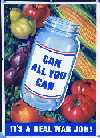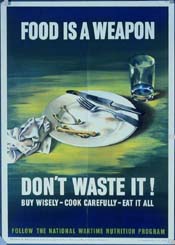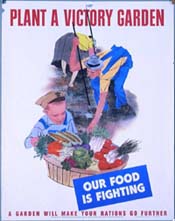Rationing arose as a clear theme of homefront lives during World War
Two. Men, women, and children, in every interview, mentioned rationing.
Many had specific, vivid memories of how rationing affected their own
homes. In this section, I will examine the national program of rationing
and its implications for cities like Worcester and the families of Quinsigamond
Village. Rationing also creates a parallel between Quinsigamond and the
rest of the nation. Other movements considered reflective of WWII may
not have been universal across the nation, but rationing was something
that touched each kitchen and every car. Therefore, experiences and thoughts
of rationing in Quinsigamond can be expanded to reflect possible national
experiences and trends. As Martha
Erickson simply stated, "You didn't get everything you wanted,
you had to have stamps, for everything."

The Office of Price Administration (OPA) was established in 1941. Throughout
the country, 8,000 rationing boards were created. Two hundred thousand
volunteers and 60,000 employees worked across the nation to administer
and enforce price controls. Rationing of food, clothing, and gasoline
had a direct effect on every home in the United States. (1)

Nineteen forty-two saw tremendous institution of rationing. The OPA was
authorized to ration goods in January, also when the Emergency Price Control
Act was passed. February saw the production of the last civilian car as
metal, steel, and labor became critical for the war effort. In May, gas
was rationed on the East coast and by July the nation's gasoline supply
was limited and controlled. (2)
Rationing worked by a system of points. The government gave each family
so many points, and each week food and clothing items were given point
values. Especially hard to get items like meat, butter, and fat were given
red stamps, worth 10 points. Also worth ten points, blue stamps were used
for coveted items like flour, bread, and sugar. (3)

In order to keep the kitchens open, the homemakers of Quinsigamond made
some adjustments. Victoria
Rydberg recalled her childhood and adolescent memories of the worst
part of rationing: not having Swedish meatballs. Her mother explained
that they didn't have stamps for the meat. Homefront families interacted
in an interesting way in the face of rationing. They would barter.
Sonja Gullbrand remembered her parents would, "if they had extra
sugar, they'd swap it with somebody else for a coffee ration 'cause they
liked coffee." This bartering system was not isolated to Quinsigamond.
Many neighborhoods across the country banded together to make the most
of rationing. One grocery store in St. Louis held all of the neighborhood's
rations and oversaw the trading to make sure every family got what they
needed.(4) In Quinsigamond, we also see the
importance of the neighborhood grocer during Depression and rationed years.
Victoria Rydberg
remembered her mother's tab at the grocer during the war years. He told
her, "Mrs. Grahn, I know you will pay me. So, you get what you want
and need for your children." The kindness and patience of the grocer
stayed with her and seemed to exemplify the general attitude of the Village
for Victoria.
Working together and depending on each other enhanced the community bond
of the Village rather than create resentment. Several interviewees recalled
helping those less fortunate in the community survive the difficult time
of rationing. As Penny Copeland
recalled, "Everyone did everything for everybody else and we never
had to worry." Victoria
Rydberg concurred saying, "We helped the poor that couldn't get
the food or didn't have stamps enough to get around." Edward
Hult managed to summarize simply saying, "If you don't help one
another, no one's going to help you." These kinds of statements are
reflective of overriding themes in the war time memories. First, an attitude
of survivalism and remembering the positive. Many interviews had these
tones throughout. These are people who have gone through very trying times,
and feel strong to have survived them. What is interesting is that they
credit much of this survival to the help of family and their community.
From this, we can learn about how important the community was to each
individual and how this manifested itself in simple, everyday tasks like
swapping rations.
One way residents of Quinsigamond supplemented their rationed diets also
allowed them to support the war effort: Victory Gardens. Quinsigamond
was peppered with Victory Gardens. Residents like Martha
Erickson who lived in three-deckers contributed to the landlord's
garden. Victoria Rydberg
shared a Victory Garden with her brothers' families on their father's
land. Evelyn Grahn
remembered canning the vegetables from her family's garden. "We had
to can and take care of things, you couldn't just eat it all." So,
they went to the Worcester Extension Service to learn how to can. During
the war years, "the Extension gave invaluable suggestions and practical
help in the matter of food production and conservation."(5)

A striking contribution from many interviews was butter. Butter and fat
were rationed. So, in their stead, families had pale, non-descript margarine
that came with orange packets of dye that was mixed into the margarine
until it looked like butter, even if it didn't taste that way. This "butter"
came up in several interviews. Tora
Carpenter thought it was magic as a child, while Penny
Copeland thought it was horrible. Butter is often spoken of in the
context of a very vivid, descriptive memory and is one of the few vivid
memories of children like Bev Bylund, Olaf
Rydstrom's daughter. Victoria
Rydberg's son would beg, "Mum, let me make the butter!"
Butter thus became a symbol for rationing in the memory of war time families.
Gasoline rationing was also done on a scale. An "A" sticker
for your automobile allowed 4 gallons of gas a week. Approximately one
half of the nations cars had "A" stickers. The other half had
either B, C, or T stickers. B stickers provided extra for war workers,
for nurses like Florence
Ingman. C stickers were for those with a "vital occupation,"
such as a doctor. Truckers were given T stickers, unlimited gasoline allowance.
Quinsigamond residents like Herbert
Berg recalled the effect gas rationing had on his business and flower
deliveries. "You stretch your gasoline requirements out for what
you could get." Others, like Norman
Burgoyne, saved gas by walking to work.
While rationing of food stuff may have created a new element of community
sharing and support, gasoline rationing had a criminal side to it. Stolen
and counterfeit stickers were used in a gasoline black-market. By 1945,
there had been 32,500 arrests, 1,300 convictions, and 4,000 gas stations
were closed.(6)
If ordinary citizens were willing to become criminals to obtain gas, clearly
transportation had larger implications for wartime citizens. The inability
to travel, to visit, changed the routines of many American families.
Marge Dahlquist recalled, "Of course you couldn't drive because
you couldn't get gas, so you couldn't really go anywhere...You were lucky
if you had gas enough to get to work." Proximity to necessities,
like work, the store, and church became critical. Entertainment required
new venues, such as within the home. And when trips did come, they were
truly exciting and appreciated. Penny
Copeland explained that "they couldn't use the car unless it
was for something real important." Evelyn
Grahn had an aunt on Long Island she used to visit, but only "if
we could get the gas." But, trips like that were few and far between.
Gas rationing made communities like Quinsigamond stationary. While many
recalled the annoyance of gas rationing, it appears the lack of mobility
increased the tightness of the community.
While rationing of food, clothes, and gasoline impacted families in Quinsigamond,
creating either annoyance or hardship, causing a lack of Swedish meatballs
and the purchase of illegal gas, there is clearly a tune of survivalism.
The notion of "we were better off than some" pervaded many interviews.
Children of the Depression, who had now started their own families, had
seen worse times and knew of many in the community who were struggling
much more than themselves. As Tora
Carpenter stated, "We survived." Olaf
Rydstrom explained they handled it, "the best way we could."
Therefore, when they spoke of rationing, it was not to complain, just
to state that's the way it was. Instead, the people of Quinsigamond reached
out to help those in need.
This attitude in Quinsigamond was instilled in this generation by their
parents during the Depression. When Victoria
Rydberg complained about missing her Swedish meatballs, her mother
told her, "You're not suffering like a lot of people are because
you've got everything you need." Penny
Copeland's mother echoed the idea of being thankful for what they
had. She also added a patriotic twist to her explanation of rationing
to her children. When Penny was "complaining about that darn butter,
my mother said, 'You better thank God you have this. And this is what
we have to do now because this is for our country. They know what is best
for us so we have to do this." The patriotic acceptance of the way
things were contributed to the community's feeling that they were sacrificing
for a cause, that they were part of a bigger picture. This idea also prevented
outcry against the system set up by the government.
Instead, the parents of Quinsigamond who survived the Depression taught
the war generation strength and acceptance. They could make do and be
thankful for what they had. They learned it was their responsibility to
help each other through the tough times of rationing and war. Evelyn
Grahn simply explained how Quinsigamond handled rationing. "We
all helped one another, if they needed something, they're not afraid to
ask." We will see this idea of a surviving, tight-knit community
arise in other areas of war time life.